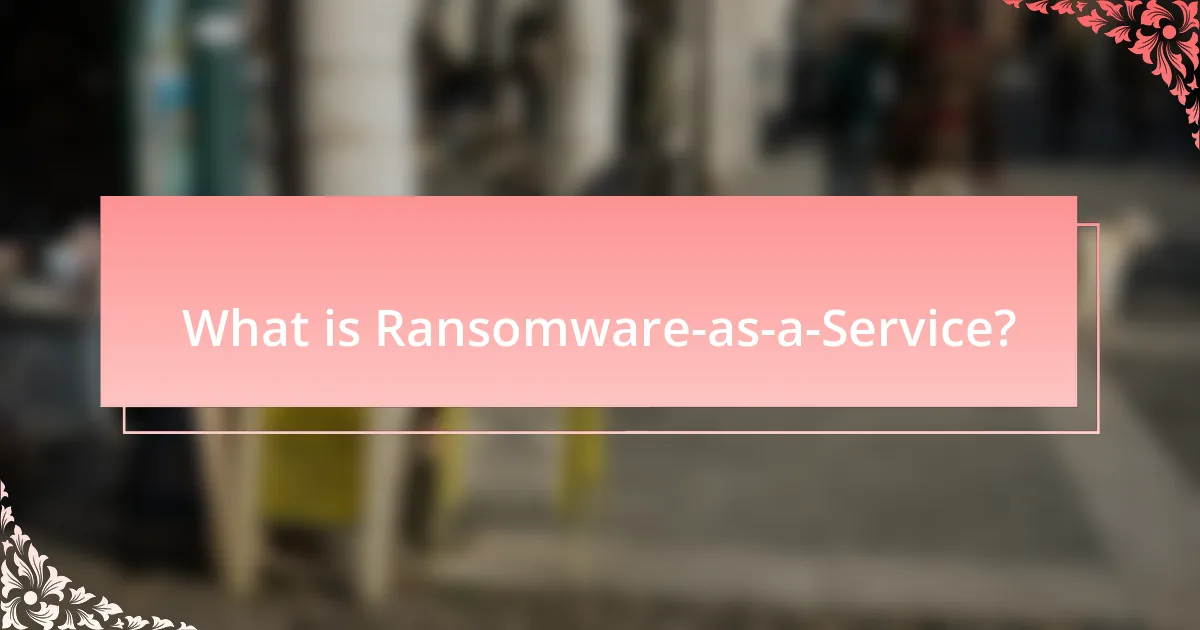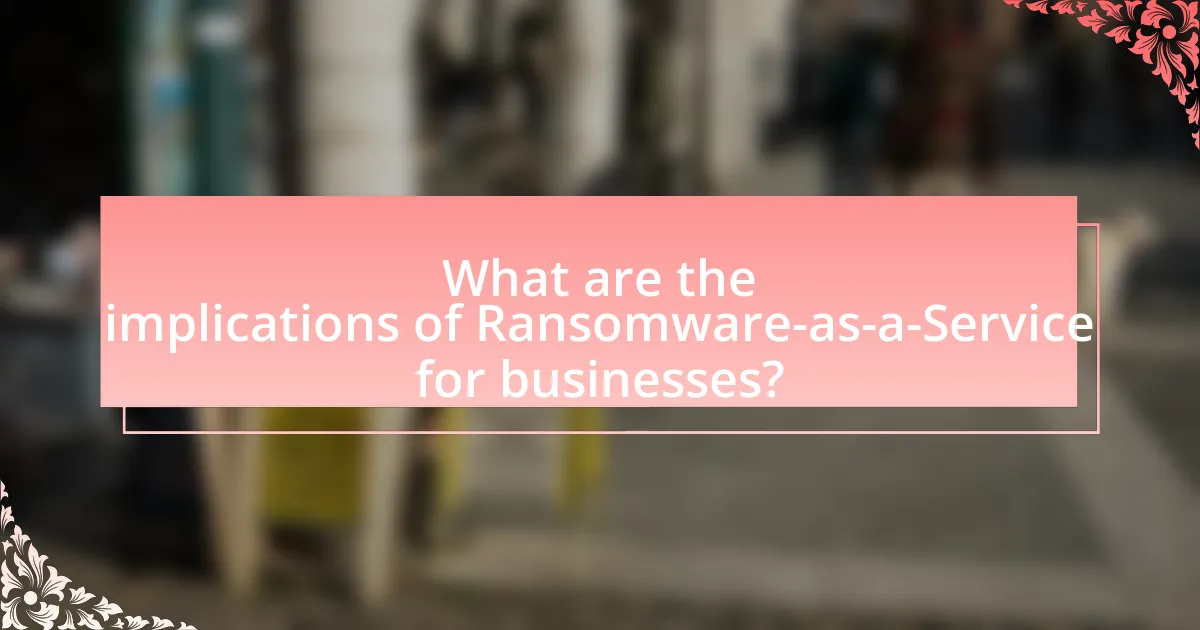Ransomware-as-a-Service (RaaS) is a growing business model that enables cybercriminals to offer ransomware tools and services to others, significantly increasing the frequency and sophistication of ransomware attacks. This article examines how RaaS operates, its key components, and the factors contributing to its rise, including the accessibility of hacking tools and the anonymity provided by the dark web. It also discusses the implications of RaaS for businesses, highlighting potential financial impacts, reputational damage, and necessary cybersecurity measures. Emerging trends in RaaS, such as double extortion tactics and law enforcement responses, are also explored, emphasizing the urgent need for businesses to adopt effective strategies to mitigate risks associated with ransomware attacks.

What is Ransomware-as-a-Service?
Ransomware-as-a-Service (RaaS) is a business model where cybercriminals offer ransomware tools and services to other criminals for a fee or a share of the ransom payments. This model allows individuals with limited technical skills to launch ransomware attacks by providing them with user-friendly interfaces and support. According to a report by Cybersecurity Ventures, the RaaS market has significantly expanded, contributing to the increase in ransomware incidents, with damages expected to reach $20 billion by 2021. This growth highlights the accessibility and profitability of ransomware attacks, making it a serious threat to businesses worldwide.
How does Ransomware-as-a-Service operate?
Ransomware-as-a-Service (RaaS) operates by providing malicious actors with the tools and infrastructure needed to deploy ransomware attacks without requiring advanced technical skills. RaaS platforms typically offer a subscription model or a profit-sharing arrangement, where users can access ransomware kits, customer support, and payment processing services for ransom demands.
These platforms often include user-friendly interfaces that allow attackers to customize their ransomware, select targets, and manage the distribution of the malware. The rise of RaaS has been facilitated by the increasing availability of these services on dark web forums, making it easier for cybercriminals to launch attacks. According to a report by Cybersecurity Ventures, the global cost of ransomware is projected to reach $265 billion by 2031, highlighting the significant threat posed by RaaS to businesses and organizations.
What are the key components of Ransomware-as-a-Service?
The key components of Ransomware-as-a-Service (RaaS) include the ransomware software itself, a distribution network, payment processing systems, and customer support services. The ransomware software is the malicious code that encrypts victims’ data, while the distribution network facilitates the spread of this malware through various channels, such as phishing emails or exploit kits. Payment processing systems enable attackers to collect ransom payments, often in cryptocurrencies to maintain anonymity. Additionally, customer support services assist affiliates in deploying the ransomware and managing negotiations with victims, ensuring a streamlined operation. These components collectively create a profitable ecosystem for cybercriminals, as evidenced by the increasing number of RaaS offerings available on dark web forums.
How do these components interact to facilitate attacks?
Ransomware-as-a-Service (RaaS) components interact by providing a streamlined platform for cybercriminals to launch attacks with minimal technical expertise. The RaaS model typically includes a user-friendly interface, malware distribution tools, and customer support, allowing attackers to easily deploy ransomware against targeted businesses. For example, the availability of pre-built ransomware kits enables even novice hackers to execute sophisticated attacks, while the support services offered by RaaS providers assist in payment collection and negotiation with victims. This interaction creates an ecosystem where attacks can be rapidly scaled, increasing the frequency and severity of ransomware incidents, as evidenced by the rise in reported ransomware attacks, which increased by 150% in 2020 according to cybersecurity reports.
Why has Ransomware-as-a-Service gained popularity?
Ransomware-as-a-Service has gained popularity due to its accessibility and the low technical barrier for entry, allowing even non-experts to launch attacks. This model enables cybercriminals to rent ransomware tools and infrastructure, significantly increasing the number of potential attackers. According to a report by Cybersecurity Ventures, the global cost of ransomware damages is expected to reach $265 billion by 2031, highlighting the lucrative nature of these services. Additionally, the anonymity provided by the dark web facilitates the proliferation of Ransomware-as-a-Service, making it an attractive option for those seeking financial gain through cybercrime.
What factors contribute to the rise of Ransomware-as-a-Service?
The rise of Ransomware-as-a-Service (RaaS) is primarily driven by the increasing accessibility of sophisticated hacking tools and the growing profitability of ransomware attacks. Cybercriminals can now easily purchase or rent these tools on dark web marketplaces, lowering the barrier to entry for less technically skilled individuals. According to a report by Cybersecurity Ventures, ransomware attacks are projected to cost businesses over $20 billion by 2021, highlighting the lucrative nature of these operations. Additionally, the anonymity provided by cryptocurrencies facilitates transactions, making it easier for attackers to profit without being traced. The combination of these factors has led to a surge in RaaS offerings, enabling a wider range of criminals to engage in ransomware attacks.
How does the accessibility of Ransomware-as-a-Service impact cybercrime?
The accessibility of Ransomware-as-a-Service (RaaS) significantly increases the prevalence and sophistication of cybercrime. This model allows individuals with limited technical skills to launch ransomware attacks, thereby expanding the pool of potential cybercriminals. According to a report by Cybersecurity Ventures, the global cost of ransomware damages is projected to reach $265 billion by 2031, illustrating the financial impact of this trend. Furthermore, the ease of access to RaaS platforms, often available on dark web forums, enables even novice hackers to execute complex attacks, leading to a surge in incidents targeting businesses and individuals alike.

What are the implications of Ransomware-as-a-Service for businesses?
Ransomware-as-a-Service (RaaS) significantly increases the risk of cyberattacks for businesses, as it lowers the barrier to entry for cybercriminals. This model allows individuals with limited technical skills to launch sophisticated ransomware attacks, leading to a surge in incidents targeting organizations of all sizes. According to a report by Cybersecurity Ventures, ransomware damages are projected to reach $265 billion globally by 2031, highlighting the financial threat posed to businesses. Furthermore, RaaS can result in operational disruptions, loss of sensitive data, and reputational damage, compelling companies to invest more in cybersecurity measures and incident response strategies.
How can businesses be affected by Ransomware-as-a-Service attacks?
Ransomware-as-a-Service attacks can severely disrupt businesses by encrypting critical data and demanding ransom for its release. This disruption can lead to significant financial losses, as businesses may face operational downtime, loss of customer trust, and potential legal liabilities. According to a report by Cybersecurity Ventures, the global cost of ransomware is projected to reach $265 billion by 2031, highlighting the financial impact on affected organizations. Additionally, businesses may incur costs related to recovery efforts, cybersecurity enhancements, and potential regulatory fines, further compounding the negative effects of such attacks.
What are the potential financial impacts on businesses?
The potential financial impacts on businesses due to ransomware-as-a-service include significant monetary losses, increased cybersecurity costs, and potential legal liabilities. Businesses can face direct financial losses from ransom payments, which can range from thousands to millions of dollars, depending on the scale of the attack. For instance, the average ransom payment in 2021 was reported to be around $220,000, according to a report by Palo Alto Networks. Additionally, businesses incur costs related to recovery efforts, such as IT services, data restoration, and system upgrades, which can further strain financial resources. Furthermore, companies may experience reputational damage leading to lost revenue and customer trust, as seen in cases like the Colonial Pipeline attack, which not only resulted in a ransom payment but also disrupted fuel supply and led to a decline in customer confidence. Legal liabilities may arise from data breaches, resulting in fines and lawsuits, compounding the financial impact.
How can Ransomware-as-a-Service affect a company’s reputation?
Ransomware-as-a-Service can severely damage a company’s reputation by undermining customer trust and confidence. When a company falls victim to a ransomware attack, it often leads to data breaches, exposing sensitive customer information. For instance, the 2020 ransomware attack on Garmin resulted in significant operational disruptions and public scrutiny, highlighting vulnerabilities in data security. Such incidents can lead to negative media coverage, loss of customers, and a decline in stock prices, as stakeholders perceive the company as incapable of protecting its assets. Furthermore, the long-term impact on brand image can deter potential clients and partners, as they may view the company as a risky business to engage with.
What measures can businesses take to protect themselves?
Businesses can protect themselves from ransomware attacks by implementing robust cybersecurity measures, including regular software updates, employee training, and data backups. Regularly updating software ensures that vulnerabilities are patched, reducing the risk of exploitation by ransomware. Employee training on recognizing phishing attempts and safe online practices can significantly lower the chances of falling victim to such attacks. Additionally, maintaining regular backups of critical data allows businesses to restore their systems without paying ransoms, as evidenced by a report from Cybersecurity Ventures, which states that 60% of small companies go out of business within six months of a ransomware attack.
What cybersecurity strategies are effective against Ransomware-as-a-Service?
Effective cybersecurity strategies against Ransomware-as-a-Service include implementing robust backup solutions, maintaining up-to-date software, and employing advanced threat detection systems. Regularly backing up data ensures that organizations can restore their systems without paying ransoms, as evidenced by a 2021 report from Cybersecurity Ventures indicating that 60% of companies that paid ransoms still did not regain access to their data. Keeping software updated mitigates vulnerabilities that ransomware exploits; for instance, the 2020 Microsoft report highlighted that 70% of ransomware attacks targeted outdated systems. Additionally, advanced threat detection systems, such as endpoint detection and response (EDR), can identify and neutralize threats before they execute, with a 2022 study by Ponemon Institute showing that organizations using EDR solutions reduced their incident response time by 50%.
How can employee training mitigate risks associated with Ransomware-as-a-Service?
Employee training can significantly mitigate risks associated with Ransomware-as-a-Service by enhancing awareness and preparedness among staff. When employees are educated about the tactics used by cybercriminals, such as phishing and social engineering, they are less likely to fall victim to these attacks. A study by the Ponemon Institute found that organizations with comprehensive security awareness training programs experienced 70% fewer successful phishing attacks. Additionally, regular training sessions can keep employees updated on the latest threats and best practices, fostering a culture of security within the organization. This proactive approach not only reduces the likelihood of ransomware incidents but also empowers employees to recognize and report suspicious activities, further strengthening the organization’s defenses against Ransomware-as-a-Service.

What trends are emerging in Ransomware-as-a-Service?
Emerging trends in Ransomware-as-a-Service (RaaS) include the increasing sophistication of attacks, the rise of subscription-based models, and the targeting of critical infrastructure. Sophisticated attacks often utilize advanced encryption techniques and double extortion tactics, where attackers not only encrypt data but also threaten to leak sensitive information. Subscription-based models are becoming popular, allowing less technically skilled criminals to access RaaS platforms for a fee, thus expanding the threat landscape. Additionally, critical infrastructure sectors, such as healthcare and energy, are increasingly targeted due to their vulnerability and the potential for significant disruption, as evidenced by high-profile incidents like the Colonial Pipeline attack in 2021.
How is the landscape of Ransomware-as-a-Service evolving?
The landscape of Ransomware-as-a-Service (RaaS) is evolving towards increased accessibility and sophistication, enabling a broader range of cybercriminals to launch attacks. Recent trends indicate that RaaS platforms are becoming more user-friendly, with subscription models and customer support, allowing individuals with limited technical skills to execute ransomware attacks. For instance, in 2022, the average ransom demanded by RaaS groups rose to over $200,000, reflecting the growing financial incentives for attackers. Additionally, the emergence of affiliate programs within RaaS ecosystems has led to a surge in collaboration among cybercriminals, further complicating the threat landscape for businesses.
What new tactics are being employed by Ransomware-as-a-Service operators?
Ransomware-as-a-Service operators are increasingly employing tactics such as double extortion, where they not only encrypt data but also threaten to leak sensitive information if the ransom is not paid. This tactic has been validated by the rise in reported incidents, with a significant increase in data leaks accompanying ransomware attacks, as seen in reports from cybersecurity firms like Coveware, which noted that 80% of ransomware attacks now involve data theft. Additionally, Ransomware-as-a-Service operators are utilizing affiliate programs to expand their reach, allowing less technically skilled criminals to launch attacks, thereby increasing the overall volume of incidents. This trend is supported by the proliferation of underground forums where these services are marketed, indicating a growing ecosystem around Ransomware-as-a-Service.
How are law enforcement agencies responding to Ransomware-as-a-Service?
Law enforcement agencies are intensifying their efforts to combat Ransomware-as-a-Service (RaaS) by enhancing collaboration, increasing resources, and implementing targeted operations. Agencies such as the FBI and Europol have established task forces that focus on tracking and dismantling RaaS operations, which have proliferated due to their accessibility and low barrier to entry for cybercriminals. For instance, in 2021, the FBI reported a significant increase in ransomware incidents, prompting a coordinated international response that included the arrest of key figures involved in RaaS schemes. Additionally, law enforcement is leveraging advanced technologies and intelligence-sharing platforms to disrupt ransomware attacks and provide support to affected organizations.
What best practices should businesses adopt to stay ahead?
Businesses should adopt a multi-layered cybersecurity strategy to stay ahead of ransomware threats. This includes implementing regular software updates, conducting employee training on phishing awareness, and utilizing advanced threat detection systems. According to a report by Cybersecurity Ventures, global ransomware damages are expected to reach $265 billion by 2031, highlighting the urgency for businesses to enhance their defenses. Additionally, organizations that conduct regular security audits and maintain an incident response plan are better positioned to mitigate the impact of ransomware attacks.
How can regular security assessments help in combating Ransomware-as-a-Service?
Regular security assessments can significantly reduce the risk of Ransomware-as-a-Service by identifying vulnerabilities before they can be exploited. These assessments involve systematic evaluations of an organization’s security posture, including penetration testing and vulnerability scanning, which help in uncovering weaknesses in systems and processes. For instance, a study by Cybersecurity Ventures predicts that ransomware damages will cost the world $265 billion annually by 2031, highlighting the urgency for proactive measures. By regularly conducting security assessments, businesses can implement timely patches, strengthen defenses, and enhance incident response strategies, ultimately mitigating the potential impact of ransomware attacks.
What role does incident response planning play in minimizing damage?
Incident response planning plays a critical role in minimizing damage during cybersecurity incidents, particularly in the context of ransomware attacks. By establishing a structured approach to identify, contain, and remediate incidents, organizations can significantly reduce the impact of such attacks. For instance, a study by the Ponemon Institute found that organizations with an incident response plan experienced 30% less damage from breaches compared to those without one. This structured planning enables rapid decision-making, efficient resource allocation, and effective communication, which are essential in mitigating the consequences of ransomware incidents.


